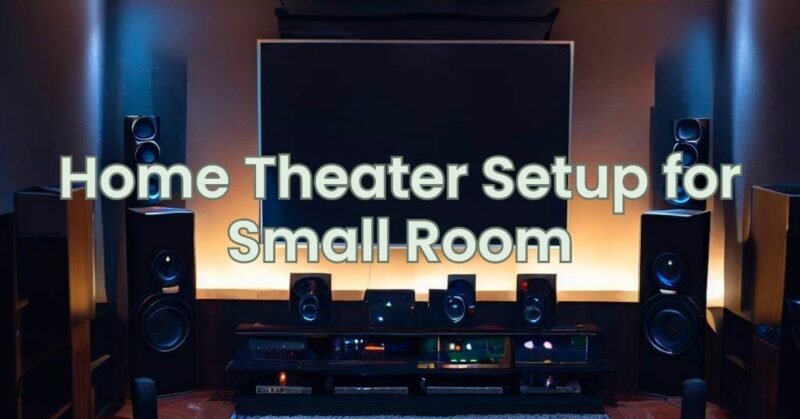Setting up a home theater in a small room can be a rewarding experience, allowing you to enjoy immersive audio and cinematic visuals within the confines of limited space. In this article, we’ll explore tips and considerations for creating an optimal home theater setup in a small room, ensuring that you make the most of your audiovisual experience.
- Room Layout and Seating Arrangement
Start by assessing the available space and determining the optimal room layout. Consider the following:
a. Screen Placement: Choose a wall where you can mount or place your TV or projector screen. Position it at a comfortable height and ensure it’s visible from all seating locations.
b. Seating Position: Arrange your seating to provide an optimal viewing angle and distance from the screen. Consider using recliners or compact seating options that can maximize space utilization.
c. Speaker Placement: Plan the placement of speakers based on the room’s acoustics and the recommended speaker setup for your home theater system. Opt for compact bookshelf or wall-mounted speakers to save space.
- Audio Considerations
Achieving quality audio in a small room requires careful consideration of speaker placement and acoustic treatment:
a. Speaker Placement: Position your main speakers (left, center, and right) according to the recommended guidelines provided by the speaker manufacturer. Place them at ear level or slightly above to ensure optimal sound projection.
b. Surround Speakers: If space permits, add surround speakers to enhance the audio experience. Consider wall-mounting them or using compact satellite speakers that can be placed strategically around the room.
c. Subwoofer Placement: Place the subwoofer in a corner or near a wall to maximize bass response. Experiment with different placements to achieve the desired balance between low-frequency impact and room acoustics.
d. Acoustic Treatment: Use acoustic panels or foam to minimize sound reflections and improve overall audio quality. Focus on treating first reflection points (side walls, ceiling) and consider bass traps to reduce low-frequency buildup.
- Visual Considerations
Optimizing the visual experience in a small room involves proper screen placement, lighting control, and projector considerations (if applicable):
a. Screen Size and Placement: Choose a screen size that fits the room and viewing distance. Avoid going too large for the space, as it may lead to discomfort or visual distortion. Consider wall-mounting the TV or using a retractable screen for projectors.
b. Lighting Control: Minimize external light sources that can wash out the screen or create reflections. Use blackout curtains or blinds to block natural light and consider ambient lighting options, such as dimmable LED lights, for a comfortable viewing environment.
c. Projector Considerations: If using a projector, select a model with appropriate throw distance and brightness suitable for a smaller room. Short-throw or ultra-short-throw projectors can reduce the required distance between the projector and the screen.
- Cable Management and Equipment Placement
To maintain a clean and organized setup:
a. Cable Management: Use cable raceways, wire clips, or cable sleeves to route and conceal cables. This not only improves aesthetics but also minimizes tripping hazards and simplifies future equipment changes.
b. Equipment Placement: Place your AV receiver, media players, and other components in a designated area near the TV or projector. Consider wall-mounting shelves or using compact media cabinets to save space and keep the setup organized.
- Room Acoustics and Furniture Placement
Experiment with furniture placement and room treatments to optimize acoustics:
a. Furniture Placement: Avoid blocking sound paths between speakers and seating areas. Arrange furniture to minimize obstructions and create an optimal listening environment.
b. Room Treatments: Consider adding area rugs, curtains, or acoustic panels to improve sound diffusion and reduce echo in a small room. Experiment with different placements to find the best balance between aesthetics and acoustics.
Remember to fine-tune your system settings, speaker levels, and audio calibration using the built-in features of your AV receiver or audio processor. Additionally, consider room correction software or professional calibration services for further audio optimization.
By following these tips and considerations, you can create an immersive home theater experience in a small room, making the most of your space without compromising on audiovisual quality. Enjoy your favorite movies, TV shows, and music in the comfort of your own home theater oasis!


